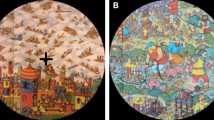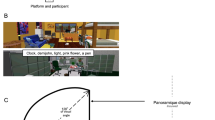Abstract
Purpose
In the upright stance, young adults better stabilize their posture when they perform precise visual or pointing movements than when they stand quietly. We tested if postural stability could be improved further if precise and pointing tasks were combined.
Method
Twenty-four healthy young adults (22 ± 12 years) performed six tasks combining three visual tasks (precise search, unprecise free-viewing and fixation tasks) and two pointing tasks (pointing-on and pointing-off tasks with laser beam on and off, respectively). In the visual tasks, participants either searched to locate targets within an image (precise task), looked at the image with no goal (unprecise task) or fixated on a cross (fixation task). In the pointing-on tasks, participants pointed a laser beam onto a small circle (2°) located in the middle of a larger circle (21°) containing the image.
Result
As expected, postural sway was reduced in the precise tasks in contrast to the fixation tasks. Contrary to expectations, both precise and pointing-on tasks did not add their stabilizing effects. Furthermore, the pointing-on task almost did not influence body movements. The participants rotated their eyes and head more and their upper back less in the precise visual tasks than in the unprecise visual tasks.
Conclusion
The participants used a stabilizing coordination to fully explore images with eye and head rotations while stabilizing their body to perform precise gaze shifts. Our findings suggest that posture stabilization is performed to facilitate success in precise visual tasks more so than to perform pointing-on tasks.


Similar content being viewed by others
Notes
For information, Dos Anjos et al. (2016) complementary showed participants significantly reduced their COP sway when they performed a condition with internal feedback. In this condition with no laser beam, participants looked at their COP sway displayed in front of them and tried to keep them within a target during trials.
Abbreviations
- AP:
-
Anteroposterior
- COP:
-
Center of pressure
- ML:
-
Mediolateral
- SD:
-
Standard deviation
- V:
-
Mean velocity
References
Balasubramaniam R, Turvey MT (2001) The handedness of postural fluctuations. Hum Mov Sci 18:795–817
Balasubramaniam R, Riley, MA, Turvey MT (2000) Specificity of postural sway to the demands of a precision task. Gait Posture 11:12–24. https://doi.org/10.1016/s0966-6362(99)00051-x
Bonnet CT, Baudry S (2016) Active vision task and postural control in healthy, young adults: synergy and probably not duality. Gait Posture 48:57–63. https://doi.org/10.1016/j.gaitpost.2016.04.016
Bonnet C, Carello C, Turvey MT (2009) Diabetes and postural stability: review and hypotheses. J Mot Behav 41:172–190. https://doi.org/10.3200/JMBR.41.2.172-192
Bonnet CT, Kinsella-Shaw JM, Frank TD et al (2010) Deterministic and stochastic postural processes: effects of task, environment, and age. J Mot Behav 42:85–97. https://doi.org/10.1080/00222890903498521
Bonnet CT, Szaffarczyk S, Baudry S (2017) Functional synergy between postural and visual behaviors when performing a difficult precise visual task in upright stance. Cogn Sci 41:1675–1693. https://doi.org/10.1111/cogs.12420
Bonnet CT, Davin T, Baudry S (2019) Interaction between eye and body movements to perform visual tasks in upright stance. Hum Mov Sci 68:102541. https://doi.org/10.1016/j.humov.2019.102541
Chen F-C, Stoffregen TA (2012) Specificity of postural sway to the demands of a precision task at sea. J Exp Psychol Appl 18:203–212. https://doi.org/10.1037/a0026661
Danna-Dos-Santos A, Degani AM, Boonstra TW et al (2015) The influence of visual information on multi-muscle control during quiet stance: a spectral analysis approach. Exp Brain Res 233:657–669. https://doi.org/10.1007/s00221-014-4145-0
Dos Anjos F, Lemos T, Imbiriba LA (2016) Does the type of visual feedback information change the control of standing balance? Eur J Appl Physiol 116:1771–1779. https://doi.org/10.1007/s00421-016-3434-7
Edwards AS (1946) Body sway and vision. J Exp Psychol 36:526–535. https://doi.org/10.1037/h0059909
Fujimoto K, Ashida H (2019) Larger head displacement to optic flow presented in the lower visual field. Percept 10:2041669519886903. https://doi.org/10.1177/2041669519886903
Fukushima J, Asaka T, Fukushima K (2008) Chapter 4.17 - Postural changes during eye–head movements. In: Kennard C, Leigh RJ (eds) Progress in brain research. Elsevier, Amsterdam, pp 335–338
Haddad JM, Rietdyk S, Claxton LJ, Huber J (2013) Task-dependent postural control throughout the lifespan. Exerc Sport Sci Rev 41:123–132. https://doi.org/10.1097/JES.0b013e3182877cc8
Horak FB (2006) Postural orientation and equilibrium: what do we need to know about neural control of balance to prevent falls? Age Ageing 35(Suppl 2):ii7–ii11. https://doi.org/10.1093/ageing/afl077
Horak FB, Nutt JG, Nashner LM (1992) Postural inflexibility in parkinsonian subjects. J Neurol Sci 111:46–58. https://doi.org/10.1016/0022-510x(92)90111-w
Hortobágyi T, Teixeira LA, Duysens J et al (2020) Is standing sway an accurate measure of fall risk and predictor of future falls in older adults? Braz J Mot Behav 14:1–3
Ivanenko Y, Gurfinkel VS (2018) Human postural control. Front Neurosci. https://doi.org/10.3389/fnins.2018.00171
Johansson J, Nordström A, Gustafson Y et al (2017) Increased postural sway during quiet stance as a risk factor for prospective falls in community-dwelling elderly individuals. Age Ageing 46:964–970. https://doi.org/10.1093/ageing/afx083
Lee DN, Lishman JR (1975) Visual proprioceptive control of stance. J Hum Mov Stud 1:87–95
McIlroy WE, Maki BE (1997) Preferred placement of the feet during quiet stance: development of a standardized foot placement for balance testing. Clin Biomech Bristol Avon 12:66–70. https://doi.org/10.1016/s0268-0033(96)00040-x
Mitra S (2003) Postural costs of suprapostural task load. Hum Mov Sci 22:253–270. https://doi.org/10.1016/S0167-9457(03)00052-6
Morrison S, Keogh J (2001) Changes in the dynamics of tremor during goal-directed pointing. Hum Mov Sci 20:675–693. https://doi.org/10.1016/S0167-9457(01)00072-0
Nagai K, Yamada M, Uemura K et al (2011) Differences in muscle coactivation during postural control between healthy older and young adults. Arch Gerontol Geriatr 53:338–343. https://doi.org/10.1016/j.archger.2011.01.003
Paillard T, Noé F (2015) Techniques and methods for testing the postural function in healthy and pathological subjects. BioMed Res Int 2015:1–15. https://doi.org/10.1155/2015/891390
Palmieri RM, Ingersoll CD, Stone MB, Krause BA (2002) Center-of-pressure parameters used in the assessment of postural control. J Sport Rehabil 11:51–66. https://doi.org/10.1123/jsr.11.1.51
Prado JM, Stoffregen TA, Duarte M (2007) Postural sway during dual tasks in young and elderly adults. Gerontology 53:274–281. https://doi.org/10.1159/000102938
Rodrigues ST, Aguiar SA, Polastri PF et al (2013) Effects of saccadic eye movements on postural control stabilization. Mot Rev Educ Física 19:614–619. https://doi.org/10.1590/S1980-65742013000300012
Rougier P, Garin M (2007) Performing saccadic eye movements or blinking improves postural control. Mot Control 11:213–223. https://doi.org/10.1123/mcj.11.3.213
Stoffregen TA, Smart LJ, Bardy BG, Pagulayan RJ (1999) Postural stabilization of looking. J Exp Psychol Hum Percept Perform 25:1641–1658. https://doi.org/10.1037/0096-1523.25.6.1641
Stoffregen TA, Bardy BG, Bonnet CT, Pagulayan RJ (2006) Postural stabilization of visually guided eye movements. Ecol Psychol 18:191–222. https://doi.org/10.1207/s15326969eco1803_3
Stoffregen TA, Hove P, Bardy BG et al (2007) Postural stabilization of perceptual but not cognitive performance. J Mot Behav 39:126–138. https://doi.org/10.3200/JMBR.39.2.126-138
Taube W, Leukel C, Gollhofer A (2008) Influence of enhanced visual feedback on postural control and spinal reflex modulation during stance. Exp Brain Res 188:353–361. https://doi.org/10.1007/s00221-008-1370-4
Acknowledgements
We wish to thank Tanguy Davin (assistant engineer) for his help with programming the study and synchronizing the various devices with MATLAB. Tanguy Davin was paid with the visionnAIRR grant (convention n°16000913) from the Conseil Regional des Hauts-de-France.
Author information
Authors and Affiliations
Corresponding author
Ethics declarations
Conflict of Interest
There is no conflict of interest.
Additional information
Communicated by Bénédicte Schepens.
Publisher's Note
Springer Nature remains neutral with regard to jurisdictional claims in published maps and institutional affiliations.
Rights and permissions
About this article
Cite this article
Bonnet, C.T., Dubrulle, D. & Singh, T. In the upright stance, posture is better controlled to perform precise visual tasks than laser pointing tasks. Eur J Appl Physiol 121, 893–901 (2021). https://doi.org/10.1007/s00421-020-04564-6
Received:
Accepted:
Published:
Issue Date:
DOI: https://doi.org/10.1007/s00421-020-04564-6




